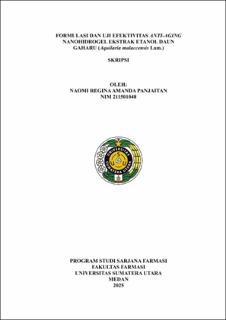| dc.description.abstract | Background: Agarwood leaves (Aquilaria malaccensis Lam.) contain flavonoids
with antioxidant activity to neutralize free radicals and prevent premature aging.
The ethanol extract of agarwood leaves is formulated into a nanohydrogel dosage
form due to its small globule size that can increase penetration into the skin.
Objective: To formulate ethanol extract of agarwood leaves into nanohydrogel
preparation, test the antioxidant activity by DPPH method and test its effectiveness
as anti-aging.
Method: Extraction of agarwood leaves was carried out by maceration method
using 96% ethanol, then phytochemical screening and characterization of simplisia
and ethanol extract of agarwood leaves were carried out. Nanohydrogel
preparations were formulated with variations in extract concentrations of 2% (F1);
4% (F2); 6% (F3) and blank (F0). Antioxidant activity testing using DPPH method.
Evaluation of nanohydrogel preparation includes organoleptic test, homogeneity,
particle size, pH, viscosity, spreadability, stability test at room temperature for 12
weeks, cycling test, irritation test on volunteers, and anti-aging effectiveness test on
12 volunteers for 4 weeks with parameters namely moisture, pore size, number of
blemishes, and wrinkles using a skin analyzer.
Results: The nanohydrogel preparation of ethanol extract of agarwood leaves has
a dark green color, distinctive odor, homogeneous, pH was 5.67-6.27, viscosity
was10543-13506.66 cPs, spreadability was 5.03-6.85 cm, does not irritate the skin,
stable for 12 weeks of room temperature storage and cycling test. Antioxidant
activity test results of nanohydrogel ethanol extract of agarwood leaves with DPPH
method showed the best IC50 value at a concentration of 6% (F3) which amounted
to 53.1461 µg/mL with a strong category. Anti-aging effectiveness test of agarwood
leaf ethanol extract nanohydrogel preparation showed the best results at a
concentration of 6% (F3) with an average percent moisture recovery of 64.04%,
pore size of 60.07%, number of blemishes 63.12% and wrinkles 70.41%.
Conclusion: Ethanol extract of agarwood leaves can be formulated as a
nanohydrogel preparation that is stable for 12 weeks of storage. Nanohydrogel
preparation of ethanol extract of agarwood leaves with 6% extract concentration
(F3) has better IC50 value and anti-aging effectiveness compared to other formulas. | en_US |


